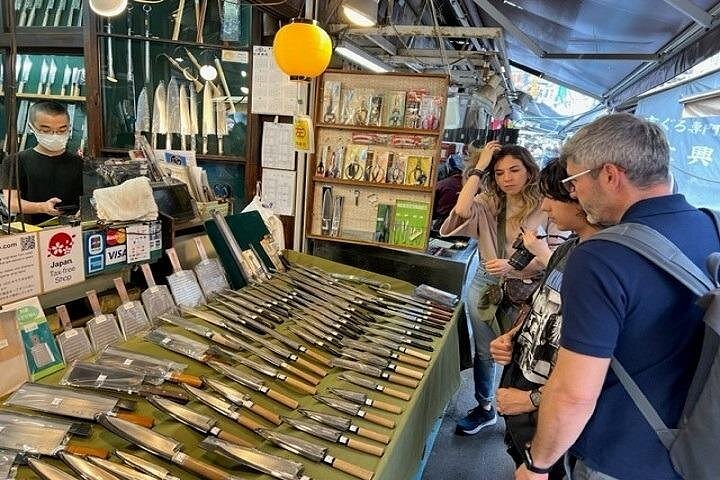
If you’re around Ueno or Asakusa, I’ve got a spot to recommend: Kappabashi Dougu-gai (Kitchenware Town).
It’s like a hub for all things food and drink related. You can find everything you need to start up a restaurant here. From utensils to plates, they’ve got it all, whether it’s for Japanese, Western, or Chinese cuisine.
And the best part? They’re super welcoming to individual customers too. So why not come check it out and find that unique piece you won’t find anywhere else?

A. Start Walking from Tawaramachi Station, South Entrance of Kappabashi Dougu-gai
Starting is Tawaramachi Station on the Ginza (Metro) Line (marked as A on the map). If you happen to be in Asakusa, walking west won’t take you too far at all!
Once you exit from Exit 1 of Tawaramachi Station and walk a bit west along the street, you’ll spot a massive statue, Jumbo Cock Statue, atop a building, just like in the photo. That’s where you’ll find the south entrance to Kappabashi Dougu-gai!
B. Dengama, a specialty store for Japanese tableware
On the right side of the southern entrance of Kappabashi Dougu-gai, you’ll find Dengama (marked as B on the map). They gather traditional Japanese tableware from pottery manufactures all across Japan, offering everything from everyday use to one-of-a-kind pieces crafted by artisans. Whether you’re looking for traditional or practical tableware that’s dishwasher and microwave safe, this shop has got you covered. It’s a great place to find memorable souvenirs from Japan!


C. Niimi Western Tableware Shop, an emporium for all things tableware
On the left side of the southern entrance of Kappabashi Dougu-gai, Niimi Western Tableware Shop (marked as C on the map) is located in the building with the giant statue on the rooftop.
Here is a comprehensive department store for tableware. You’ll find almost every type of tableware commonly used in Japan. Among them, children’s tableware is particularly popular. Dishes shaped like cars or trains are a big hit. How about picking up some as souvenirs from your trip to Japan?
D. Asakusa-ya, display shop
Heading north in Kappabashi Dougu-gai, you’ll find plenty of intriguing shops. One store, Asakusa-ya (marked as D on the map), sells signs and lanterns commonly used in Japanese Izakayas (pubs) and restaurants. While these items are typically displayed outside shops for Japanese folks, having them hang in your living room could add a unique touch of charm, don’t you think?


E. Majimaya Confectionery Tool and Gear Shop
If you’re into baking cookies or anything sweet, you’ll be delighted by the diverse range of tools in this store. Even if baking isn’t your thing, you’ll surely be amazed by the tower of cookies made from the various molds at the center of the shop. It’s incredible to see the array of shapes available for cookies, something we often just enjoy without much thought. Whether you’re into baking or not, it’s definitely worth popping in for a quick look!
F. Hashitou Main Store, chopstick specialty store
Since its founding in 1910, Hashitou has been a chopstick specialty store that has continued for more than one hundred years.
The tradition of using chopsticks originated in East Asia, but thanks to the global popularity of Chinese. Koren, and Japanese cuisine, people around the world have become increasingly adept at using chopsticks.

However, while the use of chopsticks in dining has spread worldwide, the differences in chopsticks themselves that have evolved in respective countries are still not widely known. Generally, China favors ivory (or its alternative, plastic), while Korea prefers metal chopsticks, although less attention seems to be paid to their design. Japanese chopsticks, on the other hand, are crafted from materials like wood or bamboo, meticulously polished, decorated, and often elevated to the status of art.
Visiting this store, you’ll come to appreciate the beauty of Japanese chopsticks, and perhaps you’ll want to have your own pair to cherish!


G. Ganso Shokuhin (Original Food) Sample Shop; be careful not for eat!
If you were to ask what’s in the photo, most people would probably say Sushi. However, the answer is actually magnetic clips. They’re stationery items used to hold paper on whiteboards and such. These are souvenir goods derived from the specialty of Ganso Shokuhin Sample Shop, which is making food samples. Inside the store, you’ll find a plethora of these samples that look exactly like the real thing. They make for perfect little souvenirs!

This store offers hands-on workshops where you can create food samples, just like the ones shown in the photo. The workshops run from 11:00 to 16:30, with each session lasting 40 minutes. 8 sessions are held throughout the day. However, as they’re quite popular, the spots fill up quickly, with a maximum capacity of 6 participants per session. If you’re lucky, you might be able to join one!
(You can reserve your spot by calling 0120-17-1839.)
On your way back, the easiest way is to retrace your steps and take the subway from Tawaramachi Station (marked as A on the map). Alternatively, if you take the Tsukuba Express line from Asakusa Station (marked as ❶ on the map), you can easily move to Akihabara. However, since you’re already in the area, why not extend your journey from Ueno to Asakusa, or from Asakusa to Ueno? It could be a nice addition to your trip!
⇒ If you want to extend to Asakusa, check here.
⇒ If you want to extend to Ueno, check here.
PR Made for Cooking Tool fans
Kappabashi Knife Shopping Tour with Government-Licensed Guide presented by Viator;


